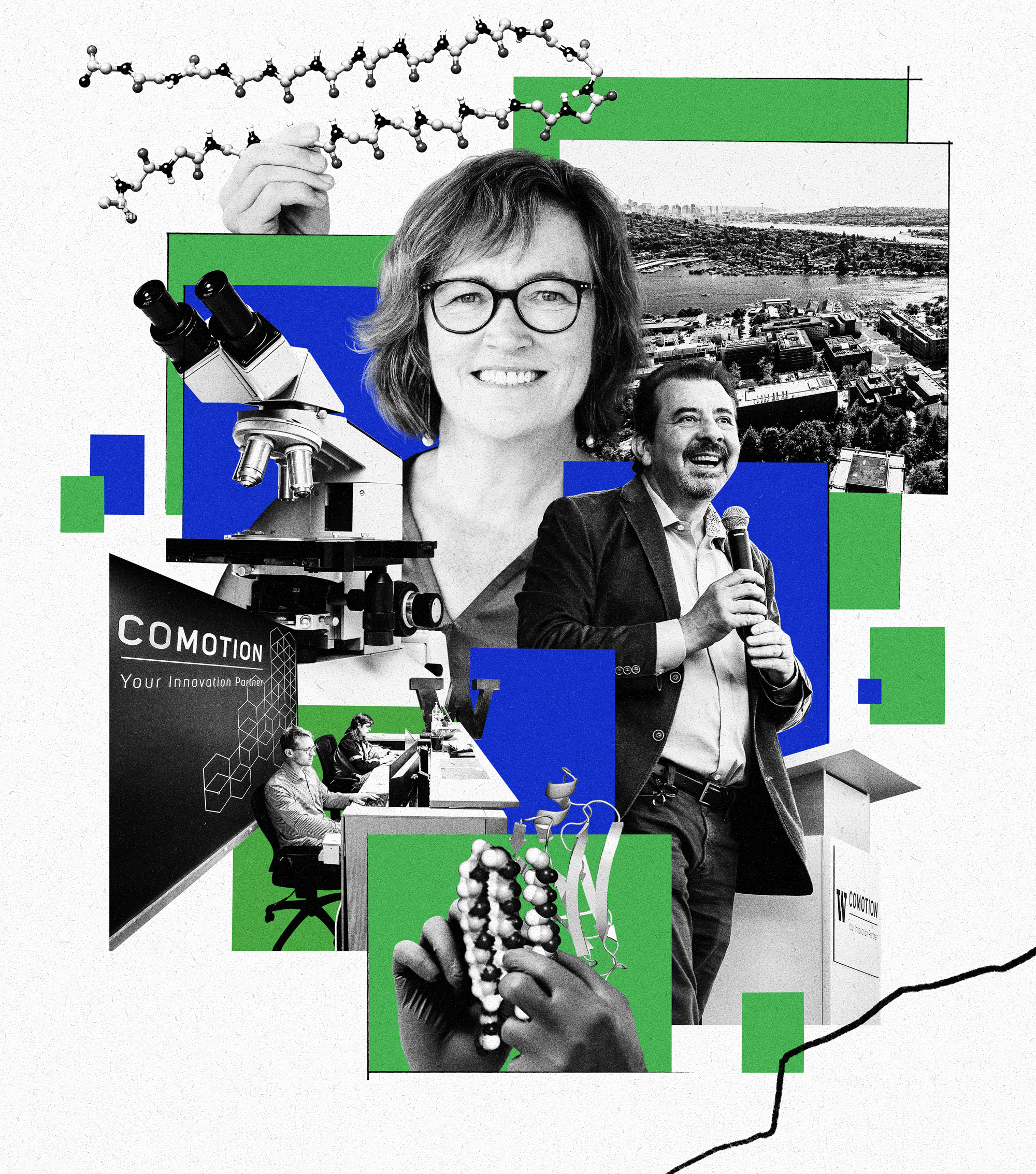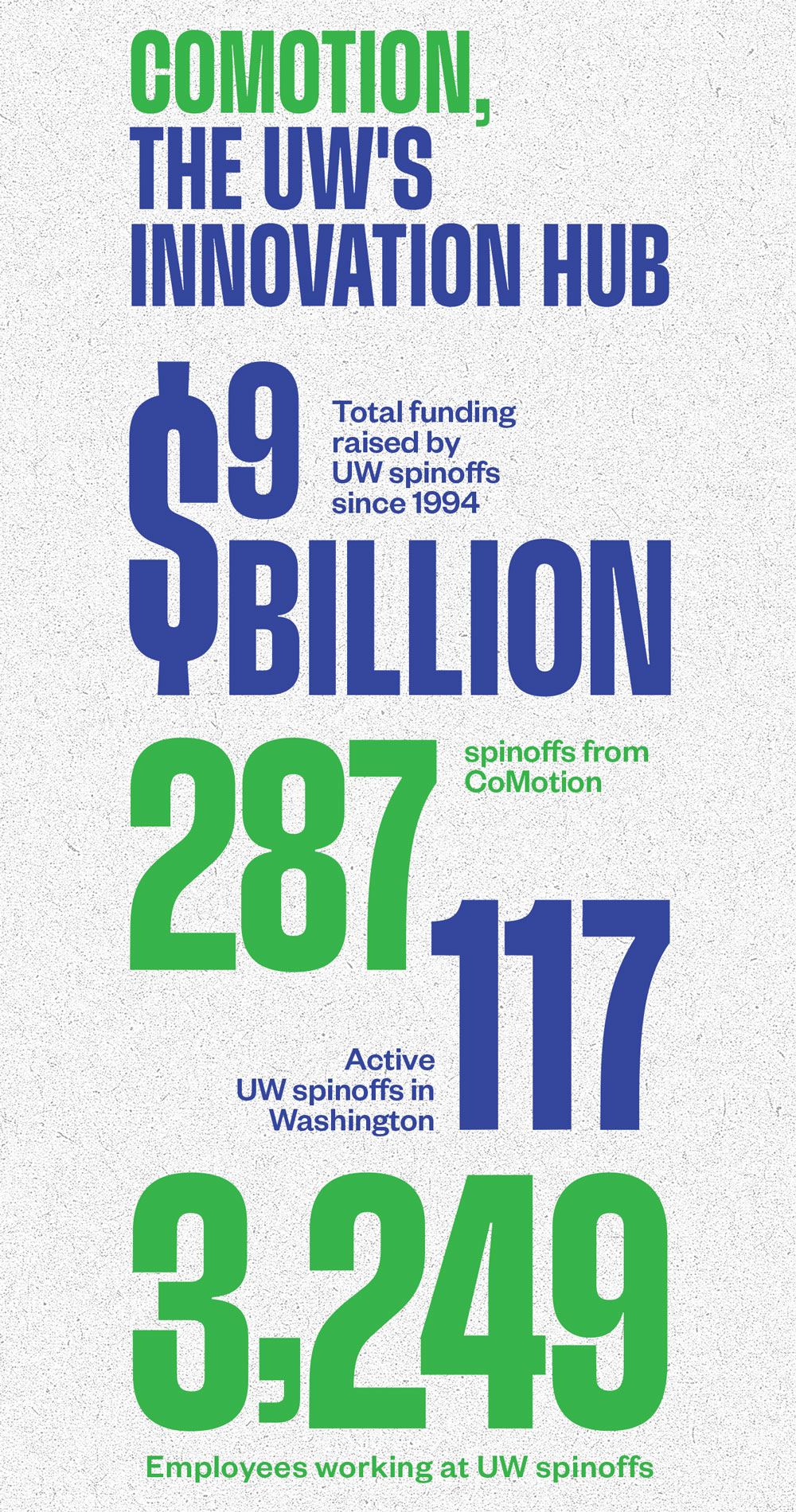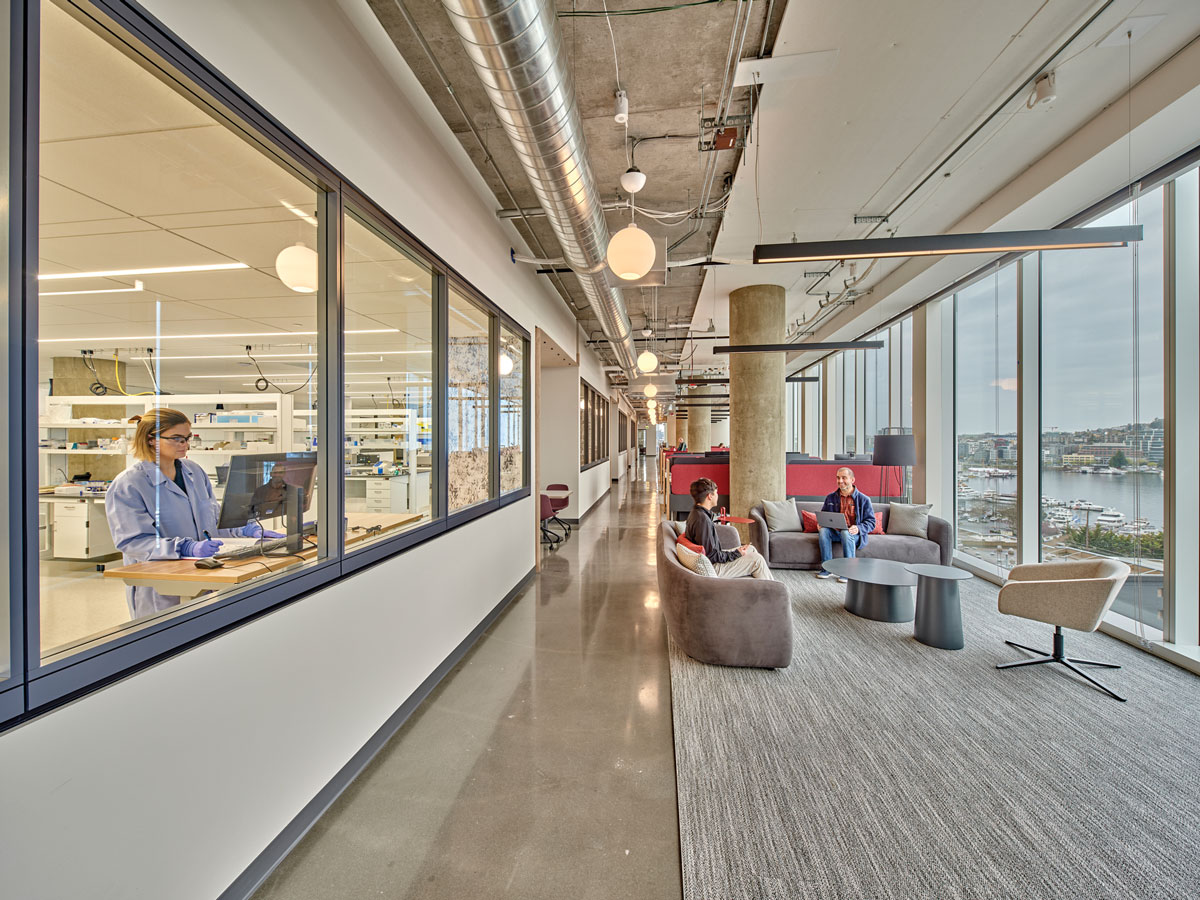Novel approach Novel approach Novel approach
With new support of private equity, CoMotion is helping a UW professor's quest to diagnose Alzheimer's earlier.
By Hannelore Sudermann | Illustration by Ewelina Karpowiak | September 2024

Valerie Daggett, a UW scientist on a quest to understand protein dynamics, has developed a novel approach for the early diagnosis and treatment of Alzheimer’s disease as well as other neurodegenerative conditions. Now, with guidance and resources from CoMotion, the UW’s innovation hub, she is on the brink of bringing her breakthrough to the real world.
Daggett discovered her talent for numbers and equations as a middle schooler in Oregon, when she cruised through high-school-level mathematics. When she got to high school, her teachers kept her busy working on proofs, priming her for research in college. “Then in college, when I started doing physics and realized you could apply the math to real things, it got even more interesting,” Daggett says from a desk in her gleaming new laboratory overlooking Lake Union. She is helming AltPep, the company spun off from her UW research to develop and commercialize a blood test for Alzheimer’s and provide therapeutics to stop its progress.
In college, Daggett pursued science, discovering she loved chemistry and then falling for proteins, the building blocks of life. She wanted to know how they worked, how they unfolded and how they influenced what happens in the human body. She followed this curiosity to graduate school and a postdoctoral position at Stanford University with structural biology professor Michael Levitt, whose work exploring the world of molecules through computers led to the 2013 Nobel Prize in Chemistry. There, she sought funding and established her own projects using computer simulations to explore protein unfolding and misfolding.
But when it came to setting up her own lab, Daggett was eager to move from the crowded, expensive Bay Area back to the Northwest. Arriving at the UW in 1993, she launched her research program to conduct computational work simulating the folding and unfolding of proteins. Raising funding wasn’t easy because it was a new area of study. “People weren’t believing it,” she says. “And it wasn’t helping that I was the only woman in the field.”
Her first lab was “in a closet in Bagley Hall,” she says, where research scientists and students perched at computers and focused on amyloids: abnormal aggregates of proteins that have been associated with diseases including Alzheimer’s, Parkinson’s and type 2 diabetes. One of their significant discoveries centered on identifying causes of neurodegenerative diseases and exploring therapeutic responses. They took their findings from their computers to the hands-on laboratory, to test them in real-life settings, and the results were increasingly promising, leading to a highly accurate method of finding misshapen proteins.
Funding her lab in the department of bioengineering through federal grants and other sources was cumbersome, Daggett says. “We had something that could really change Alzheimer’s detection and treatment, and I felt driven to move it out of academia and into a situation where we could move faster,” she says.

The UW receives more federal research dollars than any other public university in the United States. CoMotion’s role is to help bring to market the discoveries and inventions that come out of this research by providing training, IP advising, funding, licensing and mentoring opportunities. It also offers incubator space and wraparound programming to get fledgling startups on their feet.
Enter CoMotion, the technology transfer office and innovation hub at the UW. Created shortly after the Bayh-Dole Act of 1980, it helps researchers and students bring their discoveries into the real world. It has evolved into an assemblage of interconnected services and programs designed to catalyze innovation and startup creation and to build connections among UW researchers, entrepreneurs, investors and the broader community.
Five years ago, François Baneyx became UW’s vice provost for innovation and director of CoMotion. A professor of chemical engineering and bioengineering, Baneyx had the experience of launching one of his own ideas into Proteios Technology, Inc., which produces affordable and easy-to-use kits for purifying proteins and isolating therapeutic cells.
Under his leadership, CoMotion has expanded to serve more UW-affiliated innovators, providing training, IP strategy advising, funding, mentorship, incubation space and connections to industry. Daggett’s team, for example, secured bench space for its new company in CoMotion Lab’s life-sciences incubator. Two other incubators across campus focus on technology and hardware.
CoMotion has also expanded programs, workshops and resources to help startups navigate and network their way off campus. The Innovation Gap Fund provides UW researchers and students with early stage funding of up to $50,000 to bridge the journey between their research funding and early commercial investment. Baneyx is also intensifying CoMotion’s efforts toward inclusion, diversity and equity in the regional startup community, bringing in industry mentors from diverse backgrounds and providing focused support for women and people of color who are underrepresented in the startup ecosystem.

AltPep, one of the recent startups to come out of UW research, moved its headquarters to the South Lake Union tech hub neighborhood last fall. The spinoff has developed an assay to identify Alzheimer’s disease and Parkinson’s disease years before symptoms occur. Professor Valerie Daggett, the CEO of AltPep, is hopeful the test will soon get FDA approval. Photo courtesy AltPep Corp.
“Before they become a company, we can do a lot for them,” Baneyx says of all UW-related startups. “We have lawyers on staff that can help them protect their IP. We have programs that help them think about licensing their technology with different companies. We can teach them to pitch their product and match them with mentors who meet their needs.”
In 2020, the UW formed the Innovation Roundtable, convening investors, industry leaders, academics and nonprofit principals around a mission of connecting UW research with industry and addressing complex challenges like health care and environmental sustainability. A few years ago, the group, which included investors and entrepreneurs Chris DeVore, Mike Halperin, ’85, ’90, and Matt McIlwain, identified a significant challenge that seems unique to Seattle startups: a dearth of early stage investing.
“The UW does a great job of marshaling the resources and bringing in and developing talent from around the world,” says Ken Horenstein, ’10, ’16, founder and partner in Pack Ventures, LLC, a venture capital firm focused on UW alumni and campus-connected startups. He adds that university research is leading to significant discoveries in computer science and the life sciences, particularly with therapeutics, “but there’s a little bit of a gap in securing funding to help facilitate those spinouts.”
“UW founders are being overlooked and undervalued [compared to startups from Ivy League schools], even though they progress to the same mean as the Ivy Leagues in the next round of funding,” he says. While many of Pack Ventures’ partners are seasoned investors, Horenstein envisions the firm being a conduit for newer investors who want to back UW-connected startups.
Pack Ventures has invested in several startups including seven from alumni of the UW’s Institute for Protein Design. “By 2030, we want to invest in 150 UW-affiliated founders,” Horenstein says. “This is us really catching up and being competitive with other universities and having this as a resource for our founders—our students and professors.”
In early 2024, CoMotion and UW Advancement, the division responsible for fundraising, alumni relations, and marketing and communications, signed a memorandum of understanding with Pack Ventures allowing the fund specific use of UW imagery and trademarks. In exchange, the firm will work with CoMotion to plan educational and training events for UW researchers, students and faculty, and it will coordinate with entrepreneurial and startup development programs on all three campuses. It also made a non-binding commitment to gifting a small share of its profits back to the UW to support innovation.
“We feel Ken is bringing so much value by providing complementary services, teaching classes and seminars through a VC lens, and pledging to reinvest in the UW,” Baneyx of CoMotion says, adding that Pack Ventures is independent of the UW, gets no preferential access and that CoMotion works with all interested investors.
“What I hope to emphasize is what’s new with CoMotion and help people understand the complexity of what we do and the constituencies we serve,” says Baneyx. With nearly $1.9 billion in sponsored grants and contracts at the UW, there are many more discoveries and ideas to bring out of academia, he says. “Our focus is to help scale lifesaving technologies and make lives better across the world.”
“We’re pushing hard on Alzheimer’s, hoping to get into clinical trials by early next year.”
Valerie Daggett
Daggett has been working with CoMotion and its predecessors since 2007. It started with visits from the organization’s experts to help her protect technology invented in her lab. “It took about 10 years to get our platform patent,” Daggett says. “We were doing something that was really novel, and the [U.S.] patent office struggled to understand it because we sought to patent a structure, not an amino sequence.” During that time, the lab used its platform (or templated structure) with different amino acids, testing it over and over again, getting the data and showing that it worked with Alzheimer’s as well as Parkinson’s and other amyloid diseases. “The patent office finally said, ‘OK, we get it,’” Daggett says. That was in 2018. “At that point we could spin out,” she says. And her company, AltPep, was born.
With the patent and seed funding, half a workbench in Fluke Hall wasn’t going to do it. Daggett moved her lab off campus to Northlake Way Northeast to “a funky space near Ivar’s.” It was still too small. Then COVID-19 slowed everything down, but it allowed Daggett to shift her focus to finding investors. “CoMotion was important in all of that,” she says.
The AltPep assay was showing so much promise that the Food and Drug Administration designated it a Breakthrough Device, which helps expedite its development and review. In 2023, AltPep completed $52.9 million in Series B funding with investors from around the world, allowing the established company to expand its testing and development. “It also allowed us to move to our fancy new digs, our state-of-the-art lab” in South Lake Union, Daggett says. “Now we’re pushing hard on Alzheimer’s, hoping to get into clinical trials by early next year.”
Daggett says the diagnostic tool might be routinely used alongside other blood labs during check-ups. It has the potential to identify Alzheimer’s patients 10 or 20 years before they might show signs of cognitive decline, she says. If the tool spots the toxic precursors to Alzheimer’s disease, AltPep’s therapeutic treatment will bind and neutralize the toxins. This could benefit millions of people. According to the Alzheimer’s Association, 5% of people age 65 to 74, 13.1% of people age 75 to 84, and 33.3% of people age 85 or older have Alzheimer’s dementia.
Not all faculty leap into becoming CEOs of their own startups. “I’m liking this work, and I want to be involved in having a say in how it goes,” Daggett says. She still has her UW computational and experimental labs, and she and her team are doing basic research, exploring new ideas, investigating different diseases, publishing and training the next generation of scientists.
And about two miles away, on the eighth floor of a sleek new glass-encased building on Eastlake Avenue East, AltPep’s 37 employees—soon to be 50—are busy at their benches and desks. Daggett, in her new office, looks out at Lake Union and thinks about how far she has come from the closets of Bagley Hall. “Everybody gets a seat by the windows,” she says.